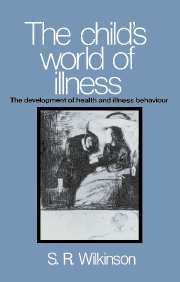Book contents
- Frontmatter
- Contents
- Acknowledgements
- Glossary
- 1 Presenting a problem
- 2 The form of dialogue
- 3 What has gone before: some background information
- 4 The primary structure to the child's world of illness
- 5 Germs and bugs: causal agents
- 6 Dirt and fresh air: the exogenous system
- 7 My castle and the good germs: the endogenous system and its boundary
- 8 ‘Pretend illness’: An analysis of how communication patterns can foster particular forms of complaints
- 9 The consultation: a form of dialogue
- 10 Health education and health promotion
- Appendixes
- References
- Index
4 - The primary structure to the child's world of illness
Published online by Cambridge University Press: 23 September 2009
- Frontmatter
- Contents
- Acknowledgements
- Glossary
- 1 Presenting a problem
- 2 The form of dialogue
- 3 What has gone before: some background information
- 4 The primary structure to the child's world of illness
- 5 Germs and bugs: causal agents
- 6 Dirt and fresh air: the exogenous system
- 7 My castle and the good germs: the endogenous system and its boundary
- 8 ‘Pretend illness’: An analysis of how communication patterns can foster particular forms of complaints
- 9 The consultation: a form of dialogue
- 10 Health education and health promotion
- Appendixes
- References
- Index
Summary
‘A child … has to locate his experience in a framework of social explanations and rules.’
(Herzlich, 1973 p. 1)It is now time to describe the framework to the child's world, the primary structure. It was this which shaped and was shaped by the children I observed. It is a framework of overt and covert rules and regulations built up on functional myths which these families found necessary for ordering their daily lives. These myths represent the ways in which they have found it necessary to account for the unknown, especially as encountered in their dealings with illness in their children. As already mentioned no disrespect for these myths is implied by calling them such; instead I am wanting to emphasise their historical social construction.
The family rules presented here represent my deductions to account for the ways in which the elicited views and described behaviour are linked together into a coherent whole. They are of necessity rather intangible (Ford, 1983), and I have not tried to alter the framework in order to test the forces binding it, or the relationship of the framework to the elicited views of the children. This represents the next stage in what would have to be a long-term project, and is what Bronfenbrenner (1979 p. 41) would term a ‘transforming experiment’.
- Type
- Chapter
- Information
- The Child's World of IllnessThe Development of Health and Illness Behaviour, pp. 63 - 109Publisher: Cambridge University PressPrint publication year: 1988



